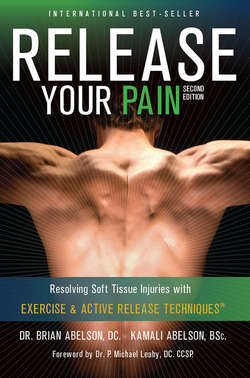Читать книгу Release Your Pain: 2nd Edition - EBOOK - Dr. Brian James Abelson DC. - Страница 7
На сайте Литреса книга снята с продажи.
ОглавлениеImpact of Soft-Tissue Injuries on your Body
Chapter
1
A soft tissue injury refers to damage to muscles, tendons, ligaments, fascia, and joint capsules in the body. This type of injury is usually referred to as a sprain, strain, contusion, repetitive strain injury, tendonitis, or bursitis.
Soft-tissue injuries are a major cause of pain and disability in our society. These often poorly understood, and badly treated, injuries affect every area of your body, from the top of your head to the bottom of your feet. Injuries to soft tissues affect the function and performance of muscles, ligaments, tendons, connective tissue, the nervous system, the circulatory system, and joints.
Residual scar tissues formed as a result of soft-tissue injuries restricts tissue movement, and results in the development of abnormal motion patterns as the body tries to compensate and work around these restrictions. These compensations, in turn, often create further structural imbalances and injury. The influence of residual scar tissue, along with its resulting compensations, can often last for years, even after what seems to be a complete resolution of the initial injury.
Soft-tissue injuries are so prevalent that most people suffer lingering effects of past soft-tissue injuries, without conscious awareness of its impact on their function and performance.
The best way to understand the compounding nature of soft-tissue injuries is to look at an example. For example, at our clinic, we commonly see patients who complain about back or knee problems.
During our evaluation, we often find that these patients also have a history of chronic foot or ankle problems. For example, an ankle sprain can cause a person to change the way they roll (pronate or supinate) their feet. This compensation then negatively affects the foot’s ability to act as a shock absorber as it flexes and rolls with each step.
Since most foot and ankle problems are not treated and rehabilitated correctly, the injured person often develops abnormal gait patterns and postural distortions as their body attempts to compensate for the restrictions caused by this soft-tissue injury.
If your feet are no longer correctly absorbing the force generated by walking or running, the excess force is redirected into other structures along your kinetic chain, including the knee and back.
This misdirected force/stress can easily cause a knee injury. The injured knee often causes even more compensations to occur throughout the body, leading to significant postural changes, decreased strength, lack of flexibility, and additional injuries throughout the body.
Note: The Kinetic Web can be thought of as a linked series of kinetic chains. Each kinetic chain is made up of individual links (your joints, bones, and soft tissues) which are connected to each other to form a Kinetic Web. Any weak link in this chain generates not only its own set of problems, but also creates problems and compensations along its entire 3-dimensional Kinetic Web.
When You Injure Your Body
Your body undergoes numerous biomechanical, physiological, and biochemical changes whenever you injure yourself. These include gait and motion compensations, stressed tissues, nerve impingements and all its accompanying effects, micro-tears causing further injuries, and numerous cardiovascular restrictions. This cause-and-effect sequence is summarized in this illustration.
Fig 1.1: Injury Escalation Cycle
The extensive array of possible soft-tissue injuries can overwhelm our health care system and are the cause of much pain and dysfunction.
But there is a realistic and effective solution for this problem. It is known as Active Release Techniques, and throughout the rest of this book we will be exploring the benefits and use of this treatment technique for the treatment and resolution of various types of soft-tissue injuries. This book will show you why these injuries occur, and how you can resolve them by combining specific exercise routines with treatments of Active Release Techniques.
